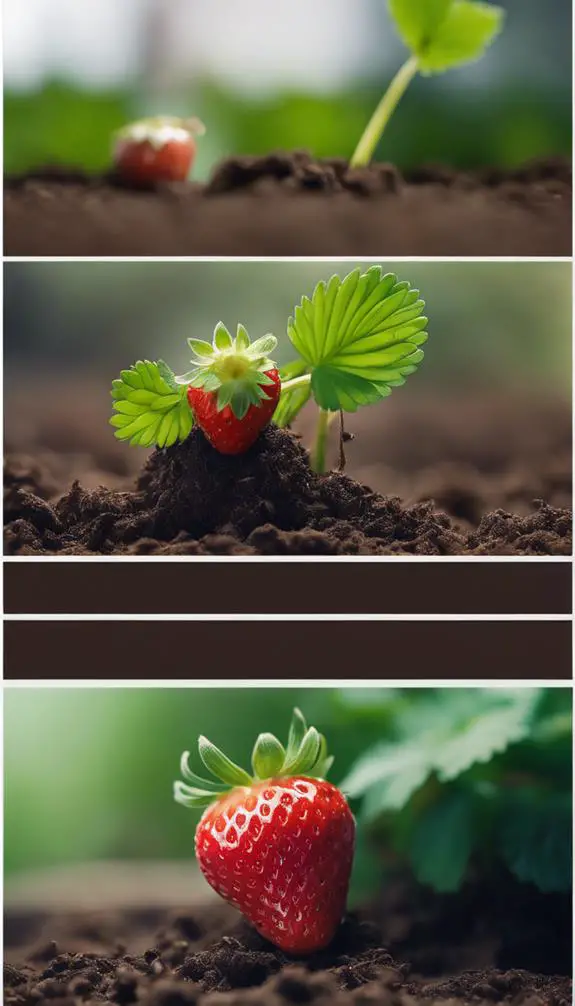You're enthusiastic to grow sweet mini peppers, and with the right techniques, you'll be enjoying a bountiful harvest in no time. First, you'll need to choose the perfect variety for your taste buds, considering factors like color, shape, and heat level. Once you've made your selection, it's time to prepare the soil, ensuring it's got the right pH balance and nutrients for your peppers to thrive. But that's just the beginning – you'll need to carefully sow your seeds, provide ideal growing conditions, and keep a watchful eye out for pests and diseases.
Summary
- Select a sweet mini pepper variety based on color, shape, and heat level, and optimize soil pH levels between 6.0 and 7.0.
- Sow seeds at a depth of about ¼ inch, 1-2 inches apart, and provide ideal conditions with consistent temperatures between 65°F to 75°F.
- Maintain consistent soil moisture, provide balanced fertilization, and control air humidity around 50-60% to promote healthy growth.
- Prune plants to promote air circulation, remove weak growth, and provide support with stakes or cages to encourage bushy growth and increase yields.
- Regularly inspect plants for pests and diseases, and use organic control methods to combat resistance, ensuring successful pollination and reproduction.
Choosing the Right Variety
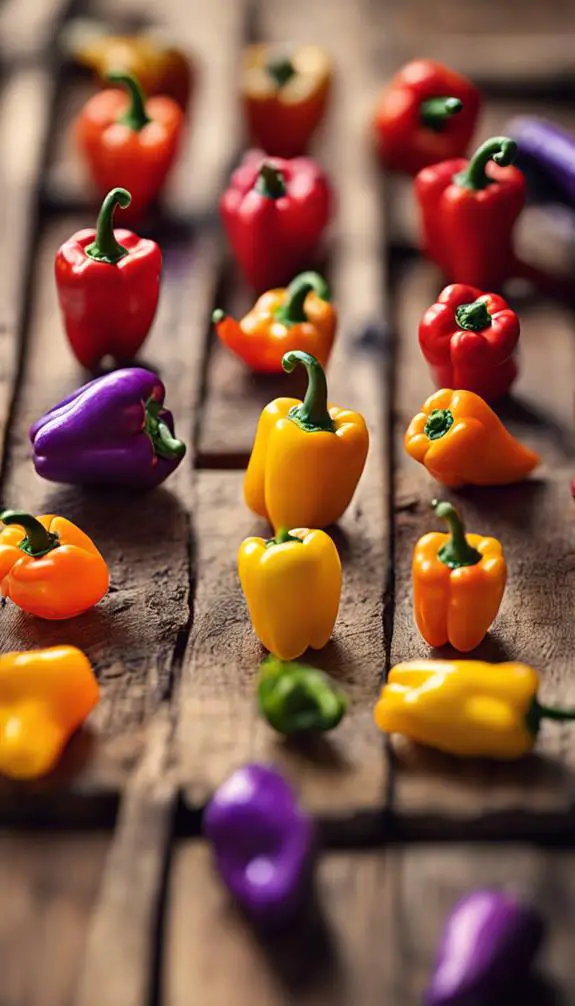
When selecting a sweet mini pepper variety, you're spoiled for choice, with numerous options available with respect to color, shape, and heat level.
You'll find a range of color options, including vibrant oranges, yellows, reds, and even purples, each with its unique flavor profile.
Some varieties, like Thai Hot, pack a spicy punch, while others, like Sweetie Baby, offer a milder taste.
Consider the flavor profiles you want to achieve and choose a variety that fits your taste buds.
Look for varieties bred for specific traits, such as high sugar content or disease resistance.
Preparing the Soil
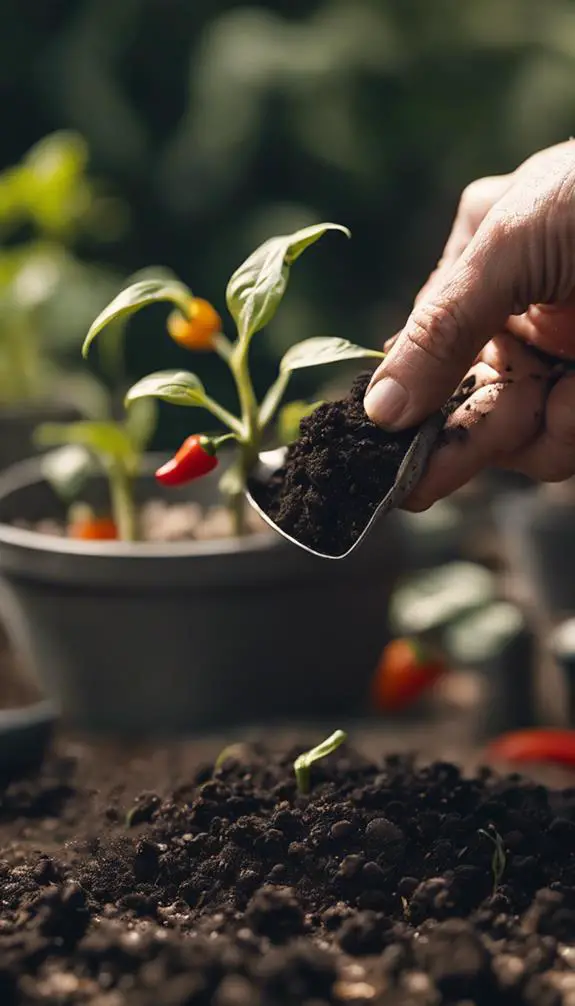
When preparing the soil for your sweet mini peppers, you'll want to select a well-draining soil type that's rich in nutrients.
Next, you'll need to optimize the pH levels, as sweet mini peppers prefer a slightly acidic to neutral soil pH, ranging from 6.0 to 7.0.
Soil Type Matters
You'll want to select a well-draining potting mix specifically designed for containers, as sweet mini peppers don't tolerate waterlogged soil.
This is vital because sweet mini peppers thrive in soil with ideal structure and texture. A mix with good soil structure allows for adequate aeration, water penetration, and root growth, while suitable soil texture facilitates water retention and nutrient availability.
Look for a mix with a balanced blend of peat moss, vermiculite, and perlite, which provides good water retention, aeration, and drainage. Avoid using regular garden soil, as it can compact and prevent proper drainage, leading to root rot and poor growth.
Optimize Ph Levels
Test the pH level of your potting mix to guarantee it falls within the ideal range for sweet mini peppers, which is between 6.0 and 6.8.
If your mix is too acidic (below 6.0), it can lead to stunted growth, while alkaline conditions (above 6.8) can cause nutrient deficiencies. You can use pH test strips or send a sample to a lab for analysis.
To adjust the pH, add lime to raise it or elemental sulfur or peat moss to lower it. Make adjustments gradually, as sudden changes can shock the plants.
Add Organic Matter
Now that you've optimized the pH level of your potting mix, it's time to prepare the soil by adding organic matter.
This step enhances the soil's structure, fertility, and overall health. Compost benefits include improved water retention, aeration, and nutrient supply.
Add a 2- to 4-inch layer of compost to your potting mix, mixing it well to guarantee uniform distribution.
If you're using manure, take advantage of its advantages, such as increased microbial activity and nutrient richness. However, make sure it's fully broken down to avoid burning your sweet mini pepper roots.
Well-rotted manure can be added at a rate of 10-20% of the total potting mix volume.
Sowing the Seeds

Precision is key when sowing sweet mini pepper seeds, as even slight variations in soil temperature and moisture can substantially impact germination rates.
You'll want to guarantee ideal seed placement, so plant them at a depth of about ¼ inch, as deeper sowing can lead to weak or deformed seedlings.
Check the seed package for freshness, as stale seeds may not germinate or will produce weak plants. Fresh seeds will typically have a higher germination rate and produce healthier seedlings.
Sow 2-3 seeds per cell or small pot, about 1-2 inches apart, to allow for proper air circulation and growth.
Providing Optimal Conditions
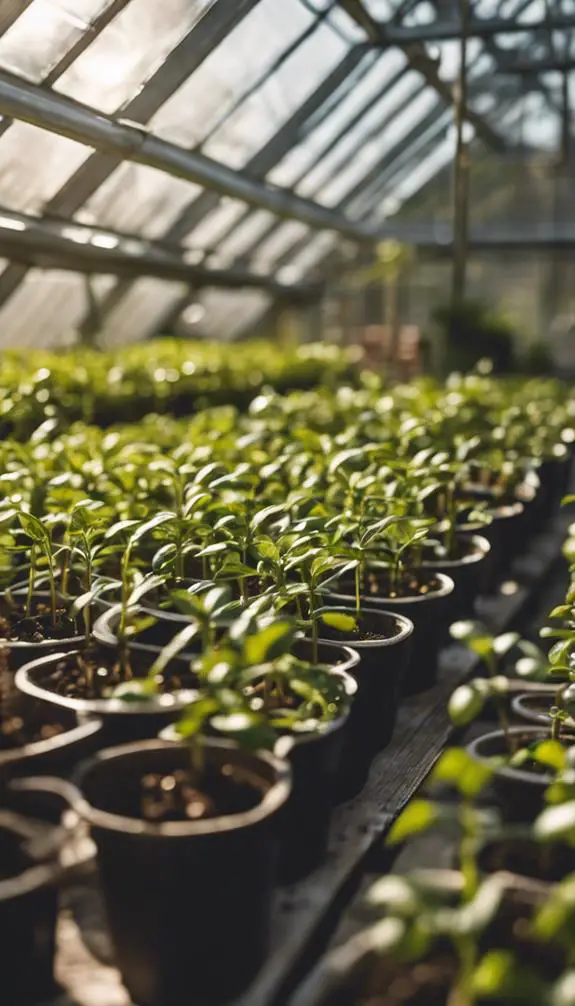
With seeds sown, your focus shifts to creating an environment that fosters healthy growth.
You'll need to provide ideal conditions for your sweet mini peppers to thrive. Climate control is essential, as these peppers require a consistent temperature between 65°F to 75°F (18°C to 24°C) during the day and no lower than 55°F (13°C) at night.
Guarantee good air circulation to prevent fungal diseases. Light exposure is also imperative, with sweet mini peppers requiring at least 6 hours of direct sunlight per day.
If indoor growing, position them near a sunny window or use grow lights with a spectrum tailored to pepper growth. By controlling climate and light, you'll set your sweet mini peppers up for success.
Watering and Humidity
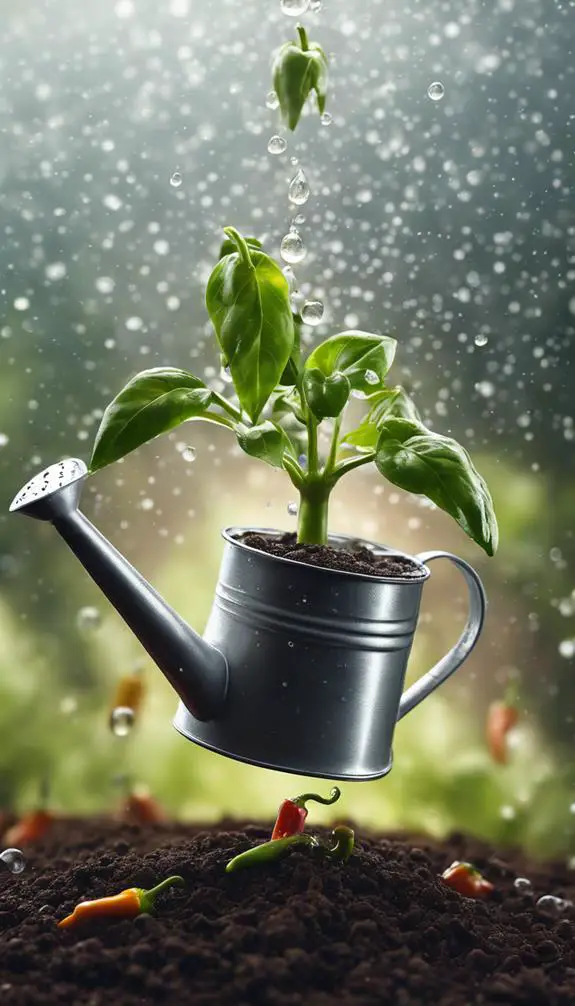
You'll want to maintain consistent soil moisture levels, keeping the top 2-3 inches of soil consistently moist but not waterlogged.
To achieve this, check the soil daily, and water when the top inch of soil feels dry to the touch.
Additionally, you'll need to control air humidity around your mini pepper plants, aiming for a relative humidity of 50-60% to promote healthy growth and prevent disease.
Soil Moisture Levels
About 60-70% of the sweet mini pepper plant's root zone should be consistently moist, but not waterlogged.
You'll want to guarantee the soil isn't too dry, as this can lead to reduced growth and lower yields.
To achieve ideal moisture levels, consider investing in soil sensors or moisture meters.
These innovative tools provide accurate readings, allowing you to adjust your watering schedule accordingly.
By monitoring soil moisture levels, you'll be able to detect even slight changes, certifying your sweet mini peppers receive the right amount of water.
This precise control will result in healthier, more productive plants.
Air Humidity Control
Most sweet mini pepper plants thrive in a humid environment, typically between 50-70% relative humidity.
To create an ideal humid microclimate, you'll want to maintain consistent air humidity levels.
You can achieve this by adjusting your mist frequency.
Aim to mist your plants 2-3 times a day, depending on the temperature and air circulation in your growing space.
Be cautious not to over-mist, as this can lead to fungal diseases.
Instead, use a fine mist to maintain a delicate balance of moisture in the air.
Fertilizing for Success
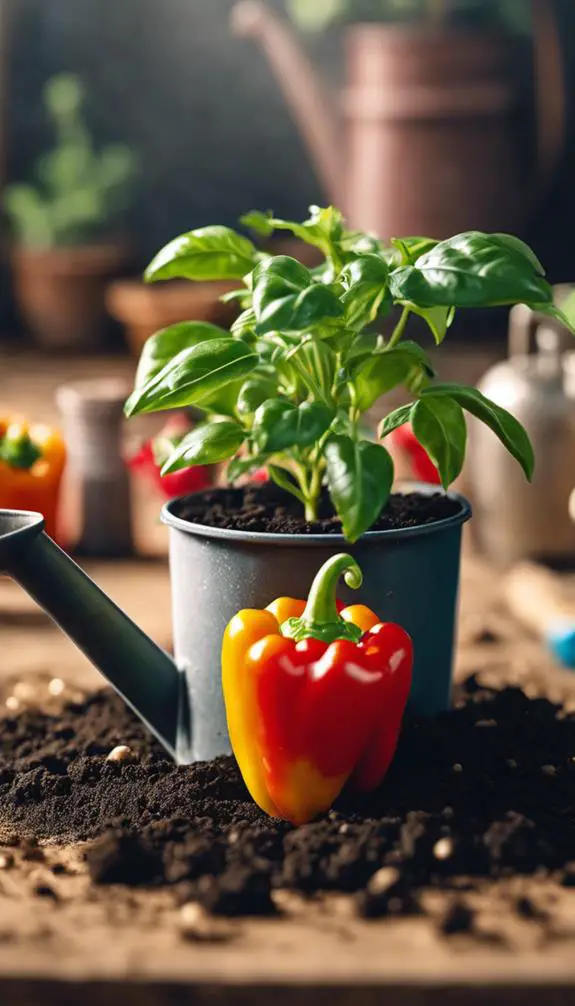
While sweet mini peppers are relatively low-maintenance, they still require adequate fertilization to produce a bountiful harvest.
You'll want to provide your plants with a balanced fertilizer that contains essential macro and micro nutrients. Micro nutrients like boron, copper, and zinc are vital for fruit development and disease resistance.
Apply a foliar spray containing these micronutrients to facilitate peak uptake. You can also side-dress with a balanced fertilizer once a month to promote healthy growth.
Be sure to follow the manufacturer's instructions and avoid over-fertilizing, which can damage your plants. By fertilizing correctly, you'll be rewarded with a plentiful harvest of sweet and crunchy mini peppers.
Pruning for Maximum Yield
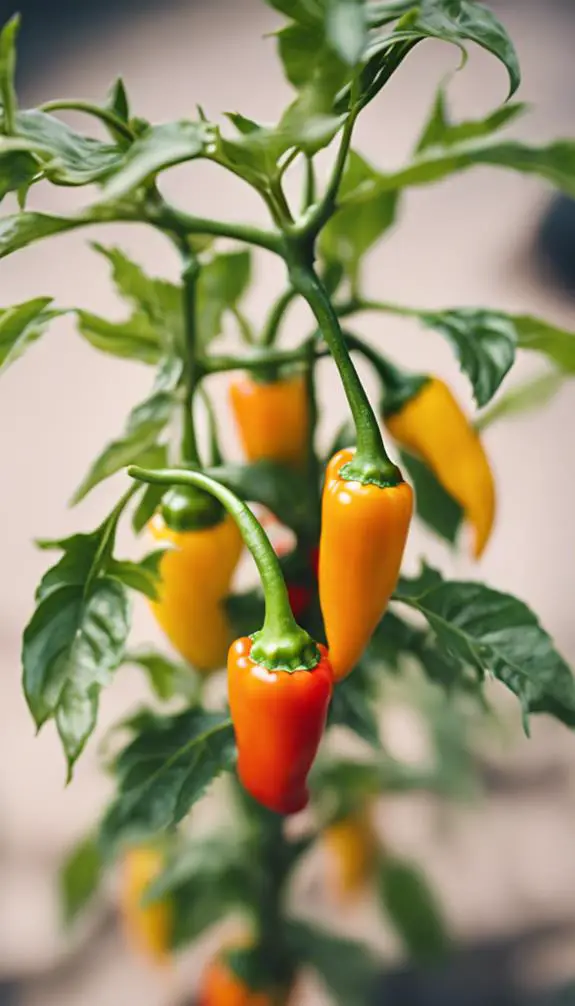
Every five to seven days, inspect your sweet mini pepper plants for signs of overcrowding or weak growth, and prune accordingly.
Remove lower leaves to promote air circulation and prevent fungal diseases. Identify and cut off weak or spindly growth, directing the plant's energy towards fruiting branches.
Employ fruitful pruning techniques to encourage bushy growth and increase yields. Pinch off the terminal bud to stimulate lateral branching, and trim back leggy stems to encourage more compact growth.
Supporting the Plants
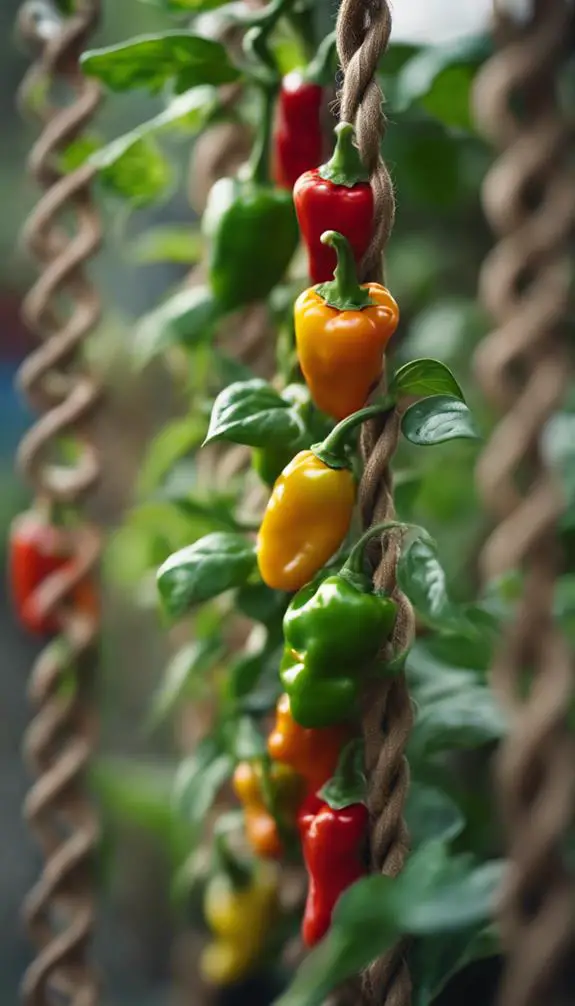
You'll need to provide support for your sweet mini pepper plants as they grow, especially when they start producing fruit.
You can use pepper plant stakes, which you'll drive into the soil near the base of the plant, or cages that surround the plant and provide structure.
Pepper Plant Stakes
Three to five tender shoots will emerge from the soil as your sweet mini pepper plants take root.
As they grow, provide support using pepper plant stakes to keep them upright and encourage even fruiting. Place stakes about 1-2 inches away from the plant stem, gently twining the stem around the stake as it grows.
This will help prevent damage to the stem and roots. Use soft ties or twine to secure the plant to the stake, allowing for some movement and growth.
Proper stake placement is vital for a healthy pepper support system, ensuring your plants receive adequate sunlight and air circulation.
Cage and Tie
Frequently, sweet mini pepper plants outgrow their stakes, requiring additional support to prevent them from toppling over.
To provide this support, you'll need to cage and tie your plants. Install a pepper enclosure, such as a tomato cage or a trellis system, around the plant.
This will give the stems something to lean against as they grow. Using twine or soft ties, gently tie the stems to the enclosure, making sure not to constrict the plant.
This will keep your sweet mini peppers upright and encourage them to grow outward, maximizing their yield. Regularly check and adjust the ties as the plant grows to guarantee ideal support.
Controlling Pests and Diseases
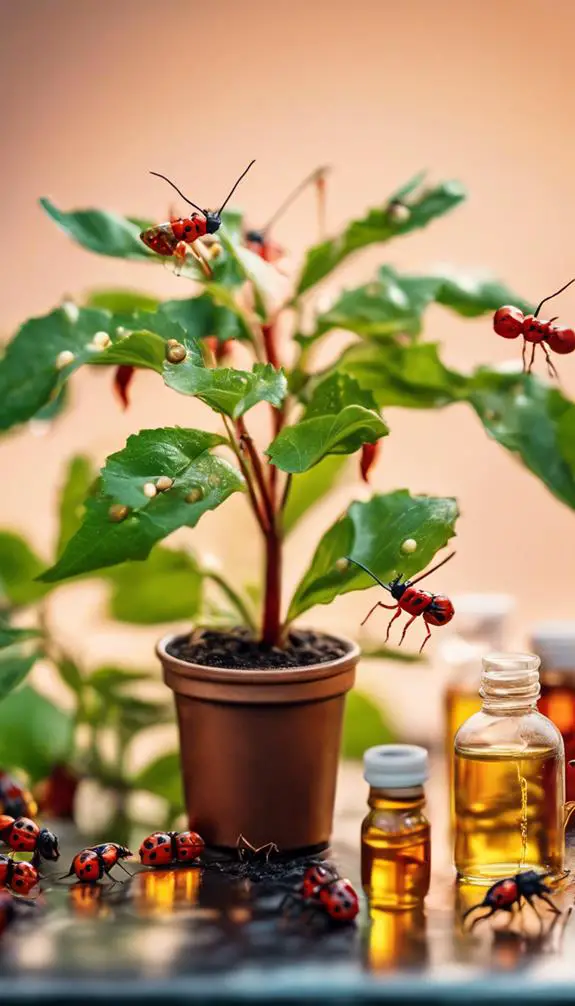
Sweet mini pepper plants, like their larger counterparts, are susceptible to pests and diseases that can substantially reduce yields and affect fruit quality.
You must regularly inspect your plants for signs of pests, such as whiteflies, aphids, and spider mites. Look for holes, discoloration, or unusual growth patterns.
For disease resistance, choose sweet mini pepper varieties with built-in resistance to common pepper diseases like tobacco mosaic virus or powdery mildew.
Keep your plants healthy by providing ideal growing conditions, including adequate air circulation, water, and nutrients. Remove infected plants or affected areas to prevent the spread of disease.
Regular pest inspection and disease-resistant varieties will help you grow healthy, productive sweet mini pepper plants.
Pollination and Reproduction
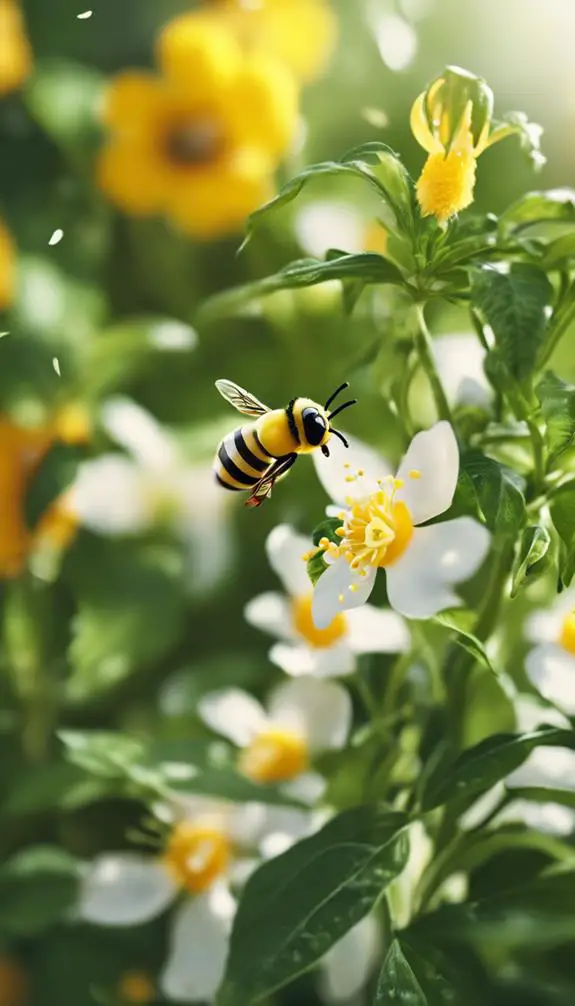
Inspect your sweet mini pepper plants regularly to guarantee successful pollination and reproduction.
You'll want to verify that your plants are receiving adequate pollination, as this is vital for fruit set and development. Encourage Bee Friends by planting a pollinator-friendly garden nearby, as they're essential for transferring pollen between flowers.
Additionally, provide support for your plants to promote Wind Pollination, which can also contribute to successful pollination. Keep in mind that sweet mini peppers are self-pollinating, but a little extra help from nature can go a long way.
Harvesting at the Right Time
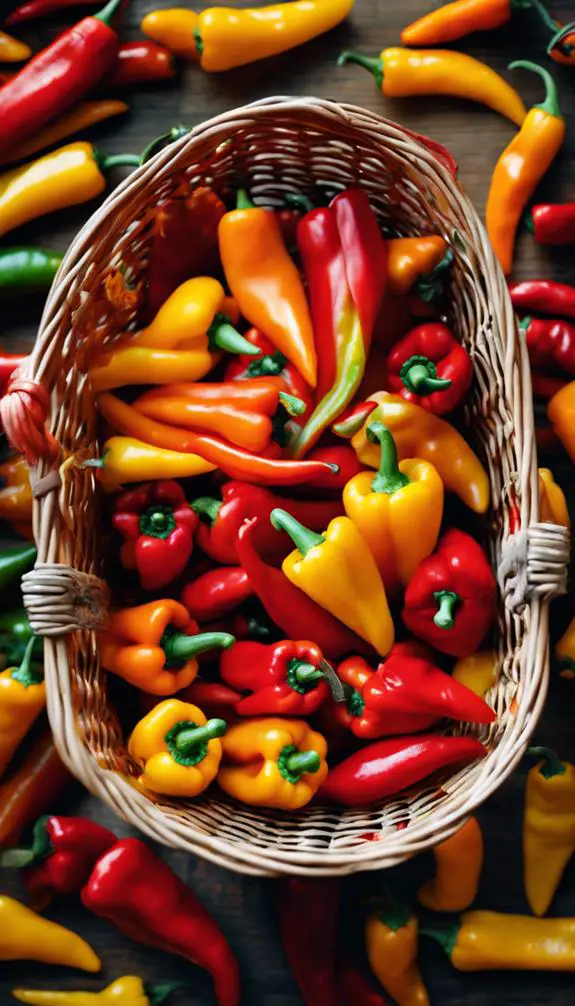
The ripeness of your mini peppers is crucial, as it directly impacts their flavor, texture, and overall quality.
You'll know they're ready when they've reached their full color, whether it's green, red, yellow, or orange. Check for slight softening to the touch and a glossy appearance.
Harvest them at the sweet spot, when they're firm but yield to pressure. This is the key to pepper perfection.
Avoid pulling them off the plant, as this can damage the stem. Instead, snip them off with scissors or pinch them off with your fingers.
The sweet surprise of biting into a crunchy, flavorful mini pepper will be worth the wait.
Storing and Preserving
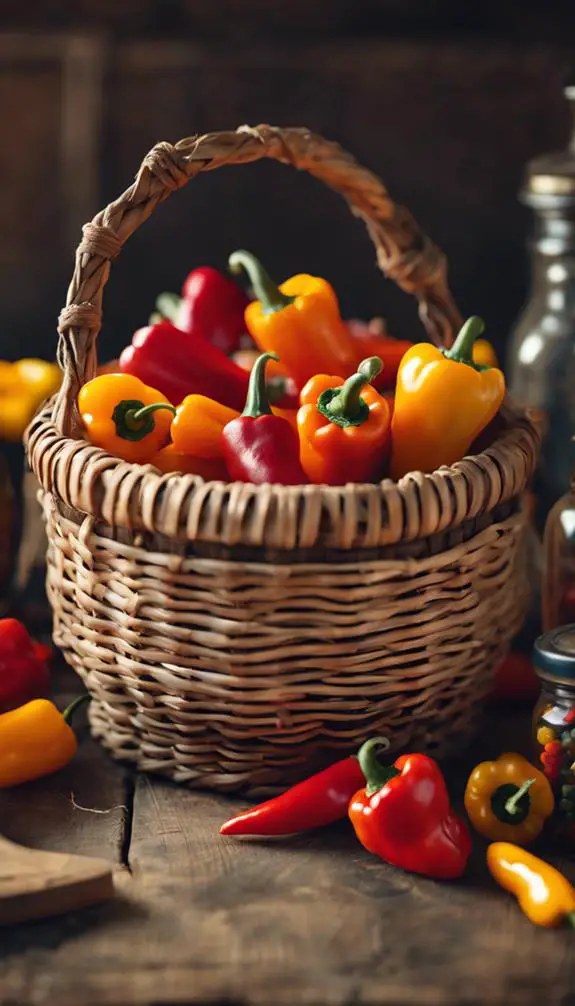
About three to five days after harvesting, mini peppers typically reach their peak freshness and flavor.
To preserve their sweetness, you'll want to store them properly. For short-term storage, keep them refrigerated in a breathable container or bag to maintain humidity.
For longer storage, consider freezer storage. Simply rinse, dry, and chop the peppers, then spread them on a baking sheet and place it in the freezer. Once frozen, transfer them to an airtight container or freezer bag.
Another option is dehydrating methods, which remove moisture to prevent spoilage. You can use a food dehydrator or your oven on the lowest heat setting. Store the dried peppers in airtight containers to enjoy year-round.
Troubleshooting Common Issues

Growing sweet mini peppers can be a rewarding experience, but it's not without its challenges.
You may encounter issues like blossom drop, where flowers fall off without setting fruit. This can be caused by temperature fluctuations, inadequate pollination, or excessive nitrogen levels.
To address this, guarantee consistent temperatures between 65-75°F (18-24°C), provide adequate pollinators, and balance your fertilizer application.
You may also encounter pest resistance, where your peppers become vulnerable to pests like aphids or whiteflies.
To combat this, introduce natural predators, practice crop rotation, and use organic pest control methods.
FAQs
Can You Grow Sweet Mini Peppers in Containers?
You can successfully grow sweet mini peppers in containers, using small pots with shallow soil, as long as you provide sufficient drainage, warm temperatures, and adequate sunlight, ensuring the soil remains moist but not waterlogged.
How Long Does It Take for Seeds to Germinate?
When you start seeds, you'll typically wait 7-14 days for germination, depending on soil temperature; ideal temps range from 70-85°F (21-29°C), with 80°F (27°C) being the sweet spot for most seeds to sprout successfully.
Can You Over-Fertilize Sweet Mini Pepper Plants?
You risk fertilizer toxicity and nutrient imbalance if you over-fertilize, as excessive nutrients can damage your plants' roots and hinder growth, so it's essential to carefully monitor and adjust fertilizer application to avoid these detrimental effects.
Do Sweet Mini Peppers Need Companion Planting?
When planting sweet mini peppers, you'll benefit from companion planting, which enhances pest protection and soil synergy, allowing you to create a resilient ecosystem where your peppers thrive, reducing the need for pesticides and boosting yields.
Can You Save Seeds From Store-Bought Sweet Mini Peppers?
You can try saving seeds from store-bought sweet mini peppers, but be aware that seed viability is often low due to hybrid or genetically modified pepper varieties, which may not produce true-to-type offspring or germinate at all.
Conclusion
You've successfully grown sweet mini peppers by choosing the right variety, preparing the soil, sowing seeds precisely, and providing ideal conditions. Consistent watering, fertilization, and pruning have promoted healthy growth. Now, enjoy your harvest, storing and preserving the peppers properly. Be prepared to troubleshoot common issues, using organic control methods when necessary. With careful attention to detail, you'll reap a bountiful crop of sweet, crunchy mini peppers.


